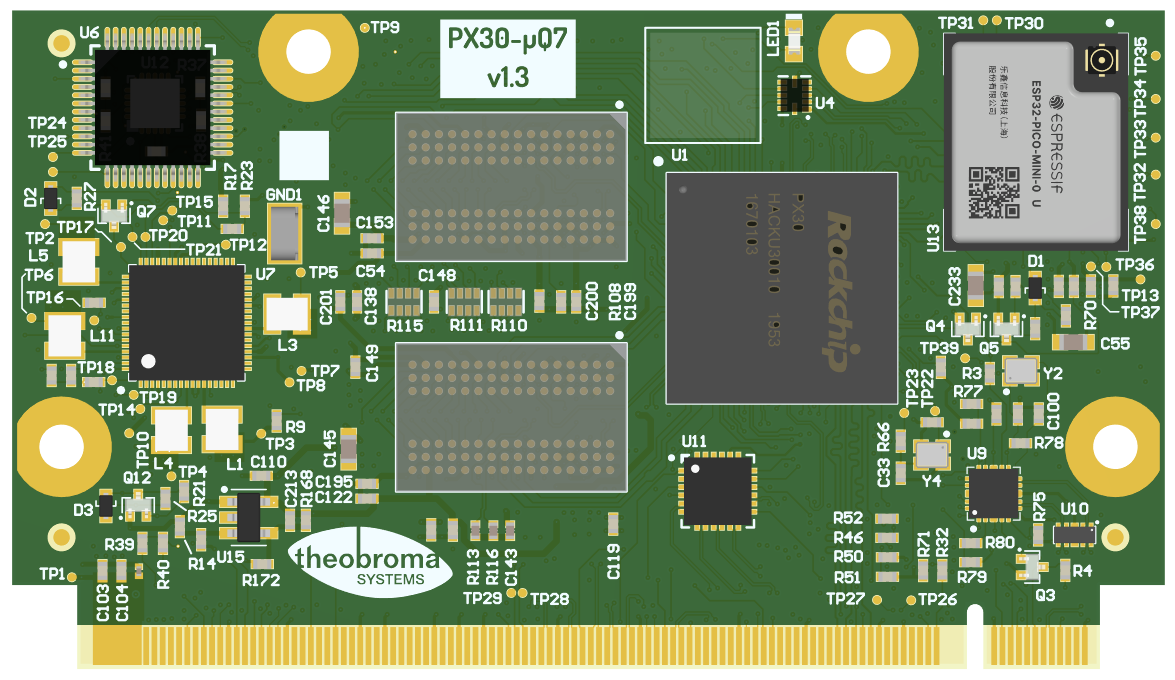8. Wifi¶
The PX30-uQ7 module features an on-board Wifi module. This chapter shows how to connect to an existing Wifi network and how to flash the wifi firmware, should the need arise.
8.1. Antenna¶
The development kit includes an antenna compatible with the Wifi module. Other antennas can be used. The connector on the antenna must be one of:
W.FL Series connector from Hirose
MHF III connector from I-PEX
AMMC connector from Amphenol
8.2. Connecting to a Wifi network¶
You can show the available wifi networks using:
nmcli dev wifi
Connect to a network using the following command (replace the network name and password as appropriate):
nmcli dev wifi connect "Theobroma Example Wifi" password "hello-px30"
You should get a message like:
Device 'wlan0' successfully activated with '79ef39fc-8f49-4719-a8d9-4d6d789bb815'.
You should have connectivity over Wifi now. You can check the IP address you received using:
ip addr show dev wlan0
Note
By default, nmcli is not available in our Yocto core-image-minimal image. However, it is available in our Yocto theobroma-extended-image image.
8.3. Flashing the wifi firmware¶
You need to have esptool.py installed on the
module.
The wifi firmware consists of three files:
bootloader.bin
partition-table.bin
eagle.bin
Save all three to the /tmp directory on the module.
Then flash the wifi module as shown below:
GPIO_BOOT=1 #GPIO0_A1
GPIO_EN=72 #GPIO2_B0
echo ff380000.mmc > /sys/bus/platform/drivers/dwmmc_rockchip/unbind
echo sdio-pwrseq > /sys/bus/platform/drivers/pwrseq_simple/unbind
if [ ! -d /sys/class/gpio/gpio$GPIO_BOOT ]; then
echo $GPIO_BOOT > /sys/class/gpio/export
fi
if [ ! -d /sys/class/gpio/gpio$GPIO_EN ]; then
echo $GPIO_EN > /sys/class/gpio/export
fi
echo out > /sys/class/gpio/gpio$GPIO_BOOT/direction
echo out > /sys/class/gpio/gpio$GPIO_EN/direction
echo 0 > /sys/class/gpio/gpio$GPIO_BOOT/value
echo 0 > /sys/class/gpio/gpio$GPIO_EN/value
sleep 1
echo 1 > /sys/class/gpio/gpio$GPIO_EN/value
sleep 1
ESPTOOL=$(PATH=/root/.local/bin/:$PATH which esptool.py)
$ESPTOOL -p /dev/ttyS3 -b 460800 --before default_reset --after hard_reset \
--chip esp32 write_flash --flash_mode dio --flash_size detect --flash_freq 40m \
0x1000 /tmp/bootloader.bin \
0x8000 /tmp/partition-table.bin \
0x10000 /tmp/eagle.bin
sleep 1
echo 1 > /sys/class/gpio/gpio$GPIO_BOOT/value
echo 0 > /sys/class/gpio/gpio$GPIO_EN/value
sleep 1
echo 1 > /sys/class/gpio/gpio$GPIO_EN/value
echo $GPIO_BOOT > /sys/class/gpio/unexport
echo $GPIO_EN > /sys/class/gpio/unexport
echo sdio-pwrseq > /sys/bus/platform/drivers/pwrseq_simple/bind
echo ff380000.mmc > /sys/bus/platform/drivers/dwmmc_rockchip/bind
Note
On Debian, the esptool package provided by the package feed is too
old. Instead, please install esptool software from pip:
apt-get -y install python3-pip
pip3 install --user esptool
Note
By default, esptool is not available in our Yocto core-image-minimal image.
